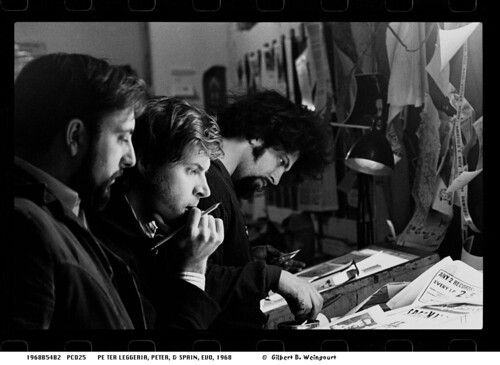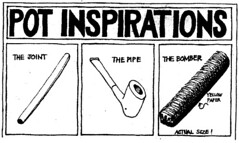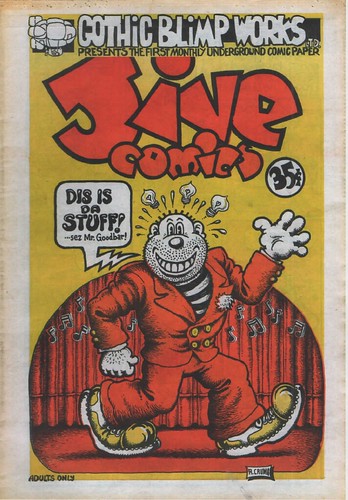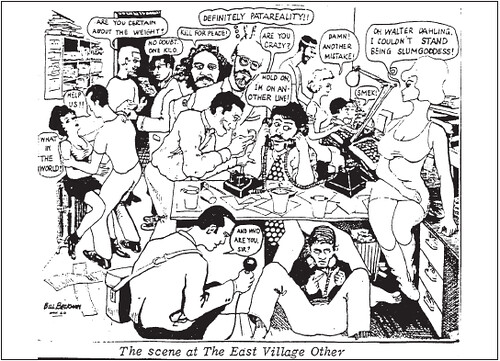Earlier this week, the Arthur L. Carter Journalism Institute launched “Blowing Minds: The East Village Other, the Rise of Underground Comix and the Alternative Press, 1965-72,” with a rousing discussion that’s now archived on the exhibit’s Website, along with new audio interviews with veterans of the Other. Over the course of seven weekend editions of The Local, we’ve heard from all but one of the EVO alumni who spoke on Tuesday’s panel. Here now, to cap off our special series, is the story of Peter Leggieri.
 Gil Weingourt Left to right: Peter Leggieri, Peter Mikalajunas, and Spain Rodriguez.
Gil Weingourt Left to right: Peter Leggieri, Peter Mikalajunas, and Spain Rodriguez.From the first day that I began working at The East Village Other, I was overcome by the sense that it was not only a newspaper but a strange and magical ship on a voyage with destiny. It seemed as though each issue printed was a new port of call, and the trip from one issue to the next, a new adventure. Many of EVO’s crew members expressed that same weird feeling – a sense of excitement and creative power.
And what a crew that was! No one was recruited. I don’t recall a resume ever being submitted. They all simply showed up and started working. EVO’s crew might just have been the greatest walk-on, pick-up team in the history of journalism. She was The Other but her staff of artists, poets, writers, photographers and musicians affectionately called her EVO. Her masthead bore a Mona Lisa eye. EVO created a cultural revolution and won the hearts and minds of a generation. She was the fastest ship in the Gutenberg Galaxy.
In the Beginning
I was the anonymous Other, the one editor-owner unknown to the public. I did not party. I did not schmooze with the literati or seek publicity. I had no time for such things. I worked seven days a week, 20 hours a day and, because of law school, I had to be sober. My friend, the poet John Godfrey, told me that I was afflicted with a Zen curse: a hermit condemned to be surrounded by people and events. That was certainly the case for me in the 1960s. Read more…
 Mar. 3, 1969 cover by Kim Deitch
Mar. 3, 1969 cover by Kim DeitchHe was a roughneck. He certainly wasn’t politically correct and his blunt management style definitely took getting used to. In fact I really didn’t know what to make of him at first. But during the time I worked at The East Village Other, I received any number of sanctimonious promises from the people I worked with that didn’t seem to amount to much. Joel Fabrikant was no sanctimonious hippie or any other kind of hippie, but he always kept his word.
I was actually drawing comics for EVO, as it was called by most of us, before Joel got there. The first time I showed up at the storefront office on Avenue A was at the start of 1967. Allen Katzman, EVO’s nominal editor, looked at the art samples I brought. He told me they were interesting, but that EVO was looking for work that was more, “psychedelic.” Psychedelic was a buzzword of the moment. Put simply it meant, “trippy,” or drug-influenced.
I didn’t have to go far to pipe directly into that. Before I even left the office, Allen Katzman introduced me to Bill Beckman, the art editor. I knew who Bill Beckman was. In fact he was one of my initial inspirations for showing up at EVO.
Back in Westchester, where I had been employed as a child care worker, perhaps nine months prior to this, I showed a co-worker some of the artwork I’d been doing in my spare time. A curious thing about this artwork was that at a certain point, it had started morphing into primitive comic strips. Read more…
 Detail from an illustration by Bill Beckman.
Detail from an illustration by Bill Beckman.I came to EVO in late 1965. I think the paper was about three issues old. Walter Bowart had quit his job as a bartender at the Dom on St. Marks Place (Ed Sanders says it was Stanley’s, maybe it was both) and had raised some money to publish what he was soon to become fond of calling “a hippie National Inquirer.” (“Hippies don’t like to read. They like pictures and big headlines.”) I had just come to New York City from Texas. At the time I wasn’t sure if I wanted to make it uptown or downtown. All that was certain was that I needed to get some kind of employment.
I was living in the basement of Bill and Debbie Beckman’s apartment on East Ninth Street between Avenues C and D. At the time, this was decidedly a sketchy neighborhood, populated by young Puerto Rican street entrepreneurs who would have duels with ripped-off car antennae, whipping each other viciously over turf or girlfriends or whatever. The old mittel Europeans, Ukrainians, and refugees who lived in the ratty tenements would scurry to get out of their way as they crossed Houston to get a knish. It would have been maybe December of 1965 when I arrived. It was shaping up as a very cold winter, with an incredible blizzard that happened just a few weeks after my arrival. Being a naive Texan, I had innocently driven my car and tried to keep it on the streets. I lost it for almost 10 days under the snow. It was all very new to me. Snow. Hippies. The East Village Other. Read more…
The Local East Village continues its celebration of the pioneering alternative newspaper of the late 1960s and early 70s, The East Village Other. This weekend, further to last week’s piece by artist Trina Robbins, we’re keeping our attention on the paper’s trailblazing illustrations, starting with an essay from Patrick Rosenkranz, the author of “Rebel Visions: The Underground Comix Revolution 1963-1975.”
 Cover of the first Gothic Blimp Works issue, by Robert Crumb
Cover of the first Gothic Blimp Works issue, by Robert CrumbI never worked for The East Village Other but I was a captivated reader from the first time I picked up an issue in 1966. As an 18-year-old naïve Catholic scholarship student at Columbia University, I was ripe for the revolution. My roommate introduced me to smoking dope that winter and my enhanced appetite often drew me to the student cafeteria, where I couldn’t help but be attracted to the radical contingent from Students for a Democratic Society sitting around their regular table. They looked to my eyes like bomb-throwing anarchists who were having wild sex every night. They often left behind copies of The East Village Other, which I picked up. It was love at first sight.
I’d never seen a publication like this before. It was full of wild accusations and bawdy language and doctored photographs. It had President Johnson’s head in a toilet bowl. It had naked Slum Goddesses, truly bizarre personal ads, and a whole different slant on the anti-war movement than my hometown paper upstate. But best of all, it had the most outrageous comic strips. The continuing saga of Captain High; the psychedelic adventures of Sunshine Girl and Zoroaster the Mad Mouse; Trashman offing the pigs and scoring babes left and right. While I enjoyed many aspects of EVO, I liked the comics the most. Read more…
 Drawing by Bill Beckman, Nov. 1966.
Drawing by Bill Beckman, Nov. 1966.I first knew Walter Bowart around 1963 or ’64 when he was a bartender at Stanley’s Bar, located at 12th Street and Avenue B. Bowart was an artist who did some design work in early 1965 for LeMar, the Committee to Legalize Marijuana, which operated out of my Peace Eye Bookstore located in a former Kosher meat store on East 10th Street between Avenues B and C.
Allen Katzman I had known since 1961 when he helped run open readings at various east-side coffee houses, such as Les Deux Magots on East Seventh, and later the Cafe Le Metro on Second Avenue. Katzman was known at the time mainly as a poet. (During his time at EVO, Katzman spelled his first name Allan.)
During the summer of 1965, Bowart, Katzman and others, including the artist Bill Beckman, Ishmael Reed, Jaakov Kohn, and Sherry Needham, decided to found a newspaper. Poet Ted Berrigan, as I recall, came up with the name, The East Village Other, with “Other” coming, of course, from Rimbaud’s famous line of 1871, “Je est un autre,” I is an Other. Another account has Ishmael Reed coining the name. (The participants in the Dada movement argued for 50 years over who first thought of the name “Dada.”) Read more…









